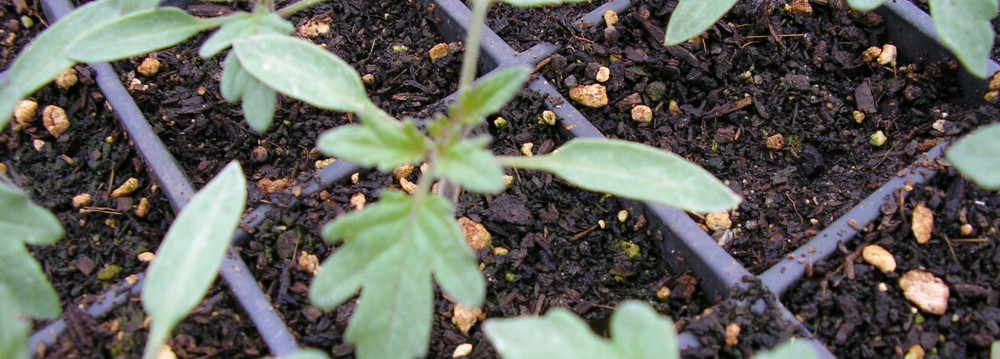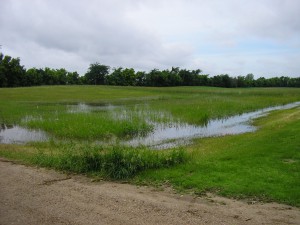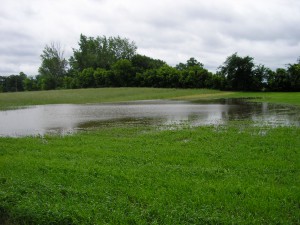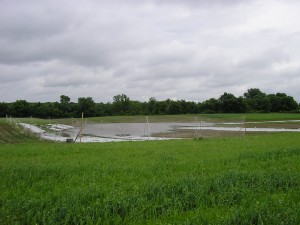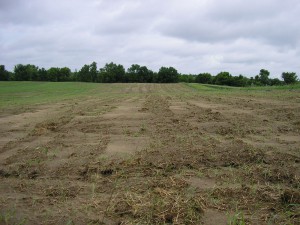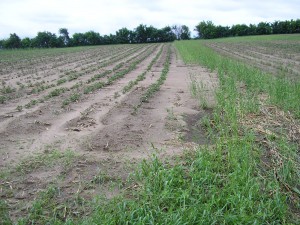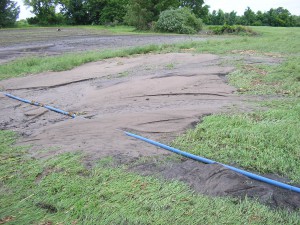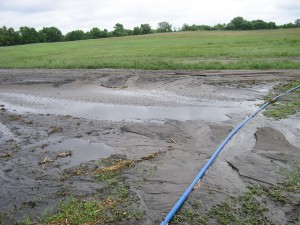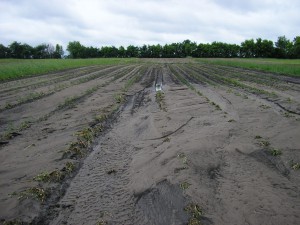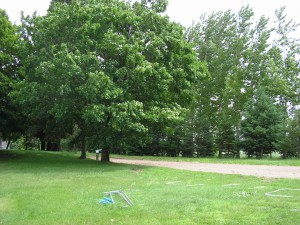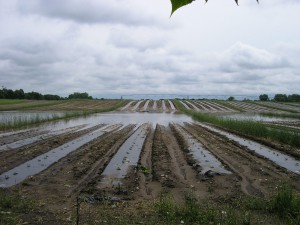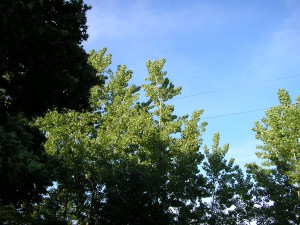Riverbend Farm Newsletter June 10, 2013
Big News! There were two days this week where I didn’t end the day with wet feet. Quite a difference a year makes. This morning we had 0.2” of rain. It was a relief that it was not more. Last year two tenths would have been cause for celebration. The grass and trees are very green and the drought has pretty well subsided for this month.
Besides never seeing the sun, it is chilly. The daily high and low temperatures are average for early May. Soil temps are only about 50º in the morning and barely make 60º in the afternoon. All the warm season crops are just sitting there.
Warmer weather and a few sunny days are in the forecast. That will help everything. I don’t know how people live where it is cloudy and wet all the time.
About a third of the field that I’m planning on using this year has yet to be plowed, the ground is too soft to drive on. Without that space we are getting close to running out of room for planting. However, we have been keeping pretty close to on track with planting and transplanting. So far only one planting of arugula and radishes has been missed. The soil is too cold, but I did put in a few rows of green beans, just in case.
We have gotten most of the green manure crops planted. Andrew and Sam planted oats and peas. Oats with the grain drill and peas with a three row planter. It is nice having several people who can drive a tractor and operate equipment. Things happen a lot faster and I can take care of things that need fixing, ordering, or just administrative overhead tasks.
In the oat and pea field there was a spot that was too wet to work ( this seems like a reoccurring theme…). Andrew broadcast seeds into those by hand and everyone raked them in. We have had ideal conditions for germinating cool season green manure crops. The oats and peas look great.
Jacob seeded most of next years vegetable field to a sorghum sudan grass hybrid. Two areas in that field had quackgrass and other weed issues, so we will cultivate them a few times before finishing the planting. The sudax is a warm season crop and It has not emerged yet.
I planted some white seeded sorghum a few days later than the hybrid and it is emerging already. The white sorghum is an open pollinated, short season variety that will produce seed in this area. It has been selected by Prairie Road Organic Seeds in North Dakota. Hopefully I will be able to replace the hybrid sudax with seed from this variety.
Potatoes are planted. One of the cultivating tractors was set up with two furrow plows and Andrew made the trenches to plant the potatoes. Everyone else dropped the seed pieces in the rows and then they were done the trenches were cultivated shut. It worked really well. It rained that night and some of the varieties are starting to emerge. Even the potato bugs are late this year. Usually they first show up on the eggplant in the greenhouse.
Last Saturday we had a crop mob. Along with our crew, they transplanted 6000 tomatoes. It was fun. There were lots of familiar faces, a fair number of CSA members, a few new people. Everyone worked together to get the job done. It was like a tide of tomato plants coming across the field. We had no more walked out of the field to eat lunch (thanks Tracy) and it started to rain. Perfect.
Sunday was dry and Monday was too. Good timing to get the peppers and eggplant set out. I introduced everyone to the transplanter and had them figure out how to make it faster than hand transplanting. After practicing on tens of thousands of onions, lettuce, kale, cabbage, broccoli, etc., they are fast planting by hand. Jordan grew up on a dairy farm and is the most comfortable maneuvering a tractor with a implement, so he got stuck driving all day.
The relative lack of rain meant that some of the ground over at Cathy’s was dry enough to work. While everyone was transplanting peppers and eggplant I went to work up the fields at Cathy’s that were dry enough to plant. Our neighbor Norman had disked up the fields over there about a month ago. By the time I got back they had set out all 5000 peppers and eggplant.
The weather was still holding Tuesday morning so we planned to put in the winter squash at Cathy’s Mette came by to help out and we set off. I disked the field that I had worked up the day before. Jordan pulled the transplanter to mark out the rows. Our dibbler would not have made a mark in that soil. Andrew, Elissa, Jacob, Mette, Nate, Noelle, and Sam started setting out squash plants as it began to rain.
Cathy has a clay soil. As it rained it became sticky. Beneath the first ¼ inch it was still dry. The top was a quagmire. See Mette’s Facebook page for pictures. It is hard to describe what it was like. After 4500 winter squash plants we took a break for lunch. Mette volunteered to go for coffee. By the time we went back, it had quit raining. 1500 pumpkins in lighter soil at the top of the field seemed to go in in no time.
Once we the pumpkins finished up we went to the south field and planted 1200 F2 tomato, pepper, and eggplant plants that were grown out of seeds that were saved from hybrid varieties last year. Most hybrids are a cross between two inbred parental lines. The hybrid is the F1 generation. If you save seeds from the hybrid, the resulting plants are an F2 generation. Not all of them look like the original hybrid or either of the parents. We will pull out all the plants that don’t look like the F1 hybrid and will save the seed from the survivors. The idea is to create a good, stable, open pollinated variety that cannot be dropped by the seed industry.
It is interesting that seed saved from Early Girl, a 1962 All American Selection winner (now owned by Monsanto), produced just about exactly 25% potato leafed plants. This is interesting on two levels. 1) 25% is what you would expect from classical genetics and 2) all potato leaf tomatoes that I know of are heirlooms or very near crosses with heirlooms ( Brandywine comes to mind). We planted the potato leaf F2 Early Girl in a group by themselves to see what they will do.
Planting lettuce, basil, and the second round of zukes and cukes was hit or miss with the rain. I think everyone is tired of getting rained on…
Besides transplanting, we have been hard at it cultivating with the tractor and hand hoeing the tens of thousands on onions. My new least favorite weed is Yellow Nut Sedge. It is a yellow, grassy looking plant that has a three sided stem. It does grow from seed, but the seed is not very viable. There are two real problems with it. One is the tubers ( the afore mentioned nuts) that it forms as the plants mature. The tubers can sprout three or four times, producing a new crop of weeds each time. If yellow nut sedge is allowed to grow, the plants form a dense sod that is very difficult to till out.
I have decided to delay the start of our CSA for a week. The cool wet spring has not been good growing weather. Tonight we had our first salad out of the field. Needless to say, we have not been doing any wholesale vegetables yet. Usually we have a few weeks of harvests before we start up the CSA. Not this year. The CSA will run a week longer at the end so the season will still be 18 weeks.
We are down to our last three cabbages in the root cellar. Onions ran out this week. There are still a few carrots and beets, and we are dangerously low on pickled hot peppers. It is time to get some fresh veggies going.
This has been a challenging start to the year and I suspect that we will not get a ‘normal’ growing season out of this. It’s not alarming, I think this variability is what we have to adapt to to succeed here now. I expect the future will be a bumpy ride. Hang on.
Greg
